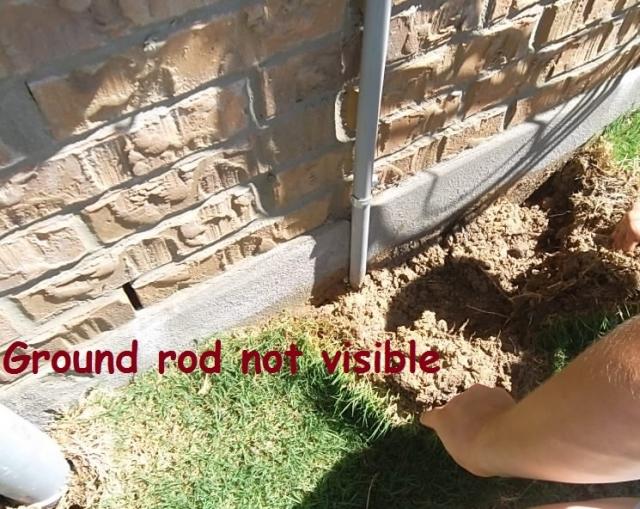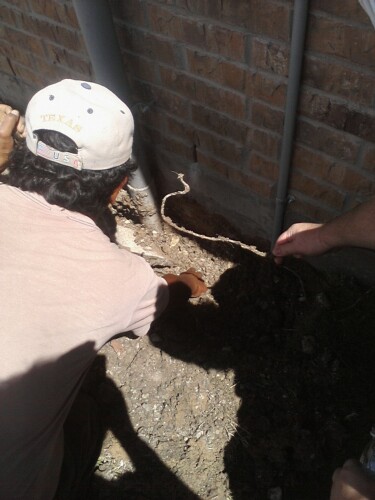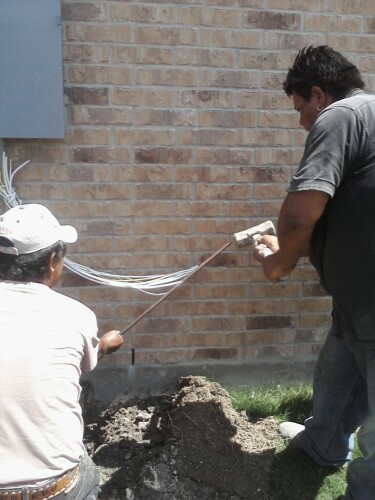4. Blogs by your San Antonio Home Inspector
Ground Rods Needed
Submitted by JoeKeresztury on Sun, 09/25/2011 - 03:46. The image shows the ground wire (grounding electrode conductor) clamped to the buried ground rod. The ground round shown is installed vertically, straight down, but realistically it will be installed at an angle and should not be at more than at a 45 degree angle and the top connection area should be left slightly exposed.
A ground rod is a metal shaft used for grounding. In the San Antonio area the ground rod is usually copper or copper coated. The only place grounding through a grounding rod should be done is at the main electrical panel. That's main panel, which is outside at the service, not sub panel which is usually in the garage or utility room area. The reason a main electrical panel is grounded through a grounding rod is to limit the voltage imposed on the entire electrical system by lightning, unintentional contact with higher voltage lines, or line surges. Grounding rods conduct electricity frrom the grounding electrode conductors directly into the earth, where it is harmlessly dissapated. Besides the grounding rod, the panel needs to also be grounded back into the electrical providers "grid".
The image shows the ground wire (grounding electrode conductor) clamped to the buried ground rod. The ground round shown is installed vertically, straight down, but realistically it will be installed at an angle and should not be at more than at a 45 degree angle and the top connection area should be left slightly exposed.
A ground rod is a metal shaft used for grounding. In the San Antonio area the ground rod is usually copper or copper coated. The only place grounding through a grounding rod should be done is at the main electrical panel. That's main panel, which is outside at the service, not sub panel which is usually in the garage or utility room area. The reason a main electrical panel is grounded through a grounding rod is to limit the voltage imposed on the entire electrical system by lightning, unintentional contact with higher voltage lines, or line surges. Grounding rods conduct electricity frrom the grounding electrode conductors directly into the earth, where it is harmlessly dissapated. Besides the grounding rod, the panel needs to also be grounded back into the electrical providers "grid".Proper grounding of the electric service main panel is essential in protecting a home and it's occupants. Ground rods along with it's connections should be replaced every 30 years or sooner, since they can and will deteriorate.

 These two photos show the ground rods verified at a San Antonio preowned home inspection (left) and a new home pre move in inspection (right)
These two photos show the ground rods verified at a San Antonio preowned home inspection (left) and a new home pre move in inspection (right)
At this San Antonio area New Home Pre Move In Inspection the ground rod was not visible as
 shown in photo as my associate pulled back the freshly laid sod in search of it. That certainly doesn't mean that it wasn't there. In many cases the ground round has been covered up by dirt, sod, landscaping, etc. In this case at the re-inspection requested by my clients- the homebuyers, the builders construction manager offered to dig up the area to prove to the homebuyers that the ground rod was there, since our original inspection report noted that the ground rod was not visible as required to be able to verify it's presence.
shown in photo as my associate pulled back the freshly laid sod in search of it. That certainly doesn't mean that it wasn't there. In many cases the ground round has been covered up by dirt, sod, landscaping, etc. In this case at the re-inspection requested by my clients- the homebuyers, the builders construction manager offered to dig up the area to prove to the homebuyers that the ground rod was there, since our original inspection report noted that the ground rod was not visible as required to be able to verify it's presence. Eventually, the builder rep helpers gave up digging after only the
Eventually, the builder rep helpers gave up digging after only the unattached copper ground wire was found (above photo)
and then a ground rod was actually brought to the home site and installed as seen in the photo below.

.
'
 This photo shows all the needed components present for a proper grounding rod system- The Ground Rod, Wire and Clamp. Unfortunetley the connection of the clamp to ground rod and wire is detached due to deterioration/corrosion from over the years and should all be replaced.
This photo shows all the needed components present for a proper grounding rod system- The Ground Rod, Wire and Clamp. Unfortunetley the connection of the clamp to ground rod and wire is detached due to deterioration/corrosion from over the years and should all be replaced.
Photos by JWK Inspections




















